Risk Management Report for Acme Medical Device Company
VerifiedAdded on 2023/06/10
|18
|4505
|62
AI Summary
This report provides a detailed analysis of the risk associated with the introduction of the latest technology device for Acme Medical Device Company. It includes a background study, qualitative and quantitative analysis of the risk management process, and recommendations for better management of risks in future.
Contribute Materials
Your contribution can guide someone’s learning journey. Share your
documents today.
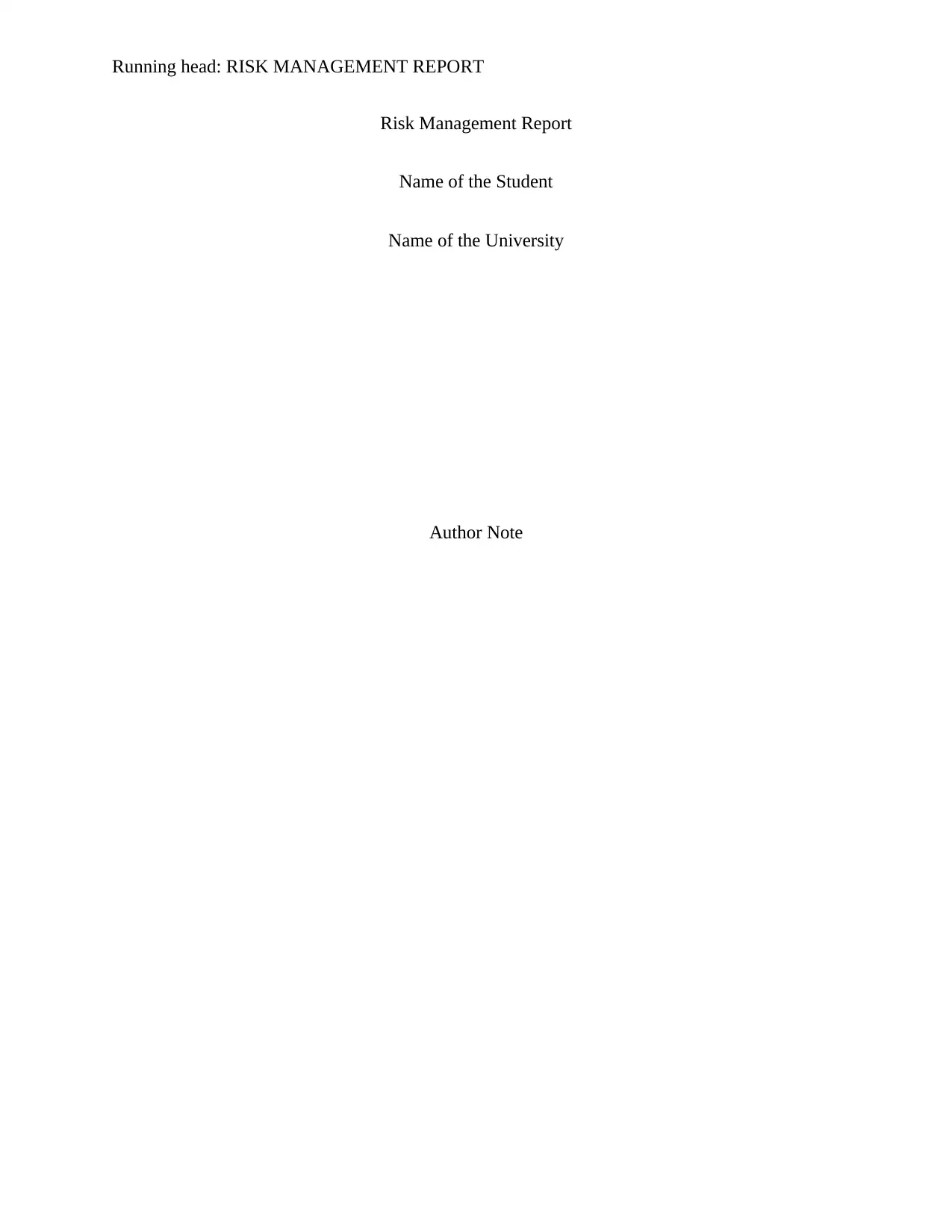
Running head: RISK MANAGEMENT REPORT
Risk Management Report
Name of the Student
Name of the University
Author Note
Risk Management Report
Name of the Student
Name of the University
Author Note
Secure Best Marks with AI Grader
Need help grading? Try our AI Grader for instant feedback on your assignments.
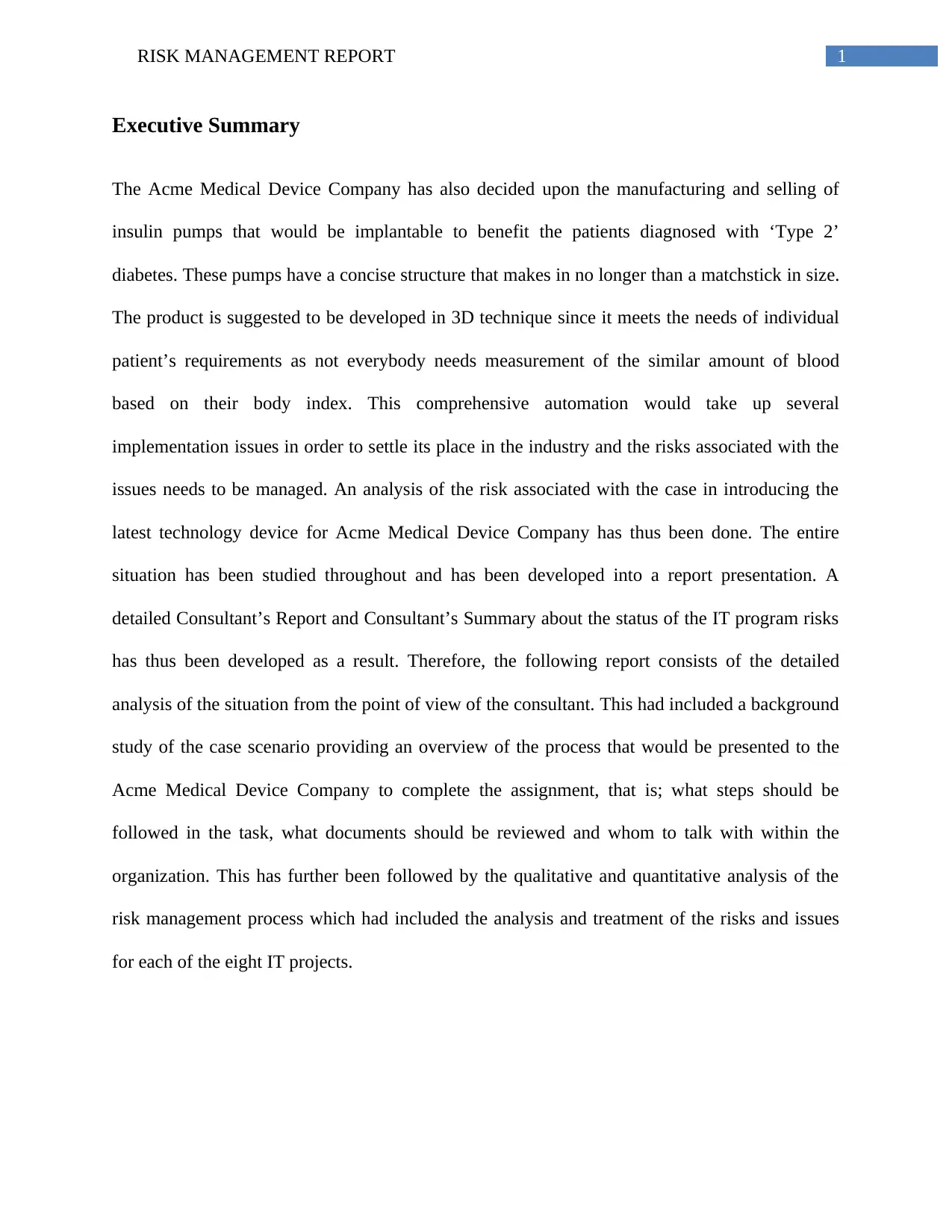
1RISK MANAGEMENT REPORT
Executive Summary
The Acme Medical Device Company has also decided upon the manufacturing and selling of
insulin pumps that would be implantable to benefit the patients diagnosed with ‘Type 2’
diabetes. These pumps have a concise structure that makes in no longer than a matchstick in size.
The product is suggested to be developed in 3D technique since it meets the needs of individual
patient’s requirements as not everybody needs measurement of the similar amount of blood
based on their body index. This comprehensive automation would take up several
implementation issues in order to settle its place in the industry and the risks associated with the
issues needs to be managed. An analysis of the risk associated with the case in introducing the
latest technology device for Acme Medical Device Company has thus been done. The entire
situation has been studied throughout and has been developed into a report presentation. A
detailed Consultant’s Report and Consultant’s Summary about the status of the IT program risks
has thus been developed as a result. Therefore, the following report consists of the detailed
analysis of the situation from the point of view of the consultant. This had included a background
study of the case scenario providing an overview of the process that would be presented to the
Acme Medical Device Company to complete the assignment, that is; what steps should be
followed in the task, what documents should be reviewed and whom to talk with within the
organization. This has further been followed by the qualitative and quantitative analysis of the
risk management process which had included the analysis and treatment of the risks and issues
for each of the eight IT projects.
Executive Summary
The Acme Medical Device Company has also decided upon the manufacturing and selling of
insulin pumps that would be implantable to benefit the patients diagnosed with ‘Type 2’
diabetes. These pumps have a concise structure that makes in no longer than a matchstick in size.
The product is suggested to be developed in 3D technique since it meets the needs of individual
patient’s requirements as not everybody needs measurement of the similar amount of blood
based on their body index. This comprehensive automation would take up several
implementation issues in order to settle its place in the industry and the risks associated with the
issues needs to be managed. An analysis of the risk associated with the case in introducing the
latest technology device for Acme Medical Device Company has thus been done. The entire
situation has been studied throughout and has been developed into a report presentation. A
detailed Consultant’s Report and Consultant’s Summary about the status of the IT program risks
has thus been developed as a result. Therefore, the following report consists of the detailed
analysis of the situation from the point of view of the consultant. This had included a background
study of the case scenario providing an overview of the process that would be presented to the
Acme Medical Device Company to complete the assignment, that is; what steps should be
followed in the task, what documents should be reviewed and whom to talk with within the
organization. This has further been followed by the qualitative and quantitative analysis of the
risk management process which had included the analysis and treatment of the risks and issues
for each of the eight IT projects.
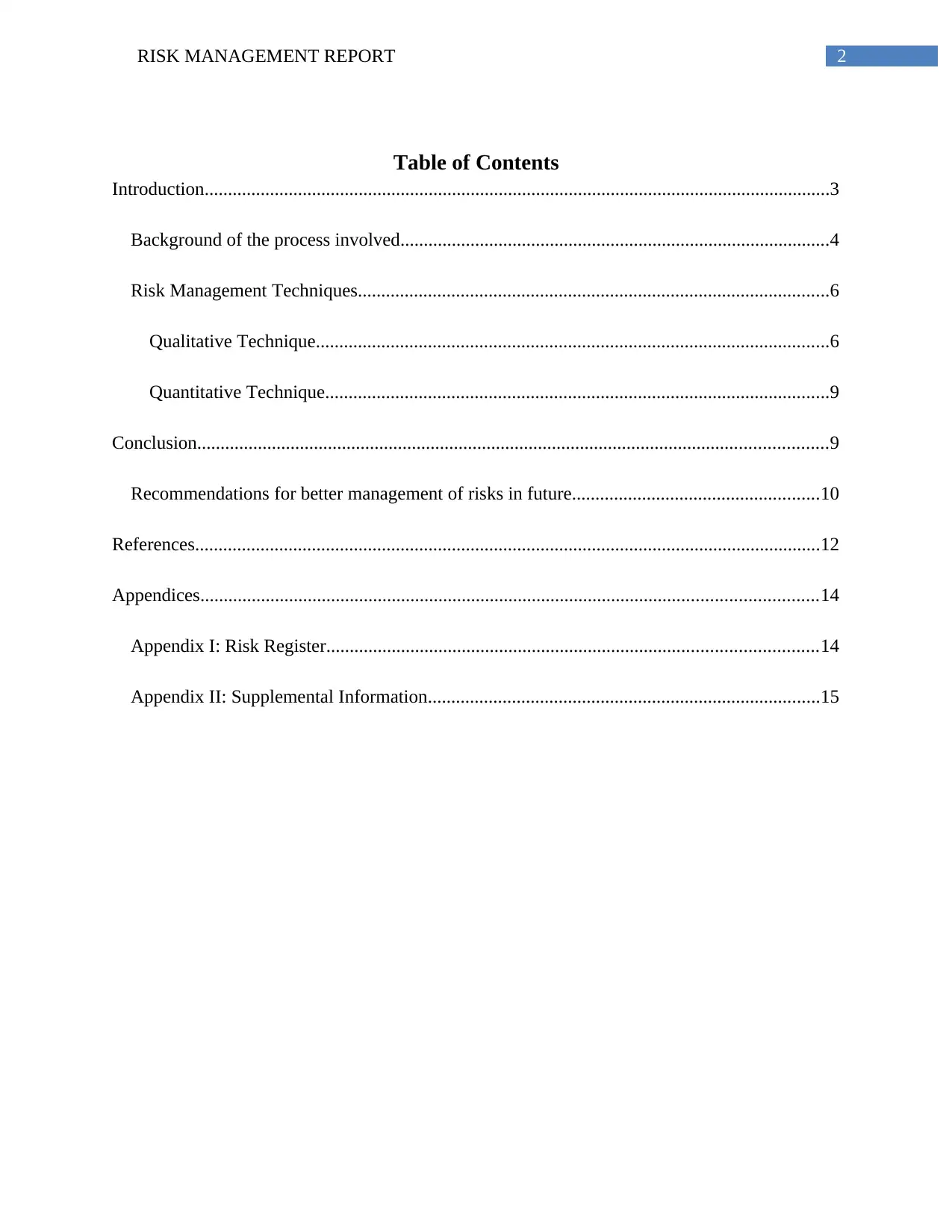
2RISK MANAGEMENT REPORT
Table of Contents
Introduction......................................................................................................................................3
Background of the process involved............................................................................................4
Risk Management Techniques.....................................................................................................6
Qualitative Technique..............................................................................................................6
Quantitative Technique............................................................................................................9
Conclusion.......................................................................................................................................9
Recommendations for better management of risks in future.....................................................10
References......................................................................................................................................12
Appendices....................................................................................................................................14
Appendix I: Risk Register.........................................................................................................14
Appendix II: Supplemental Information....................................................................................15
Table of Contents
Introduction......................................................................................................................................3
Background of the process involved............................................................................................4
Risk Management Techniques.....................................................................................................6
Qualitative Technique..............................................................................................................6
Quantitative Technique............................................................................................................9
Conclusion.......................................................................................................................................9
Recommendations for better management of risks in future.....................................................10
References......................................................................................................................................12
Appendices....................................................................................................................................14
Appendix I: Risk Register.........................................................................................................14
Appendix II: Supplemental Information....................................................................................15
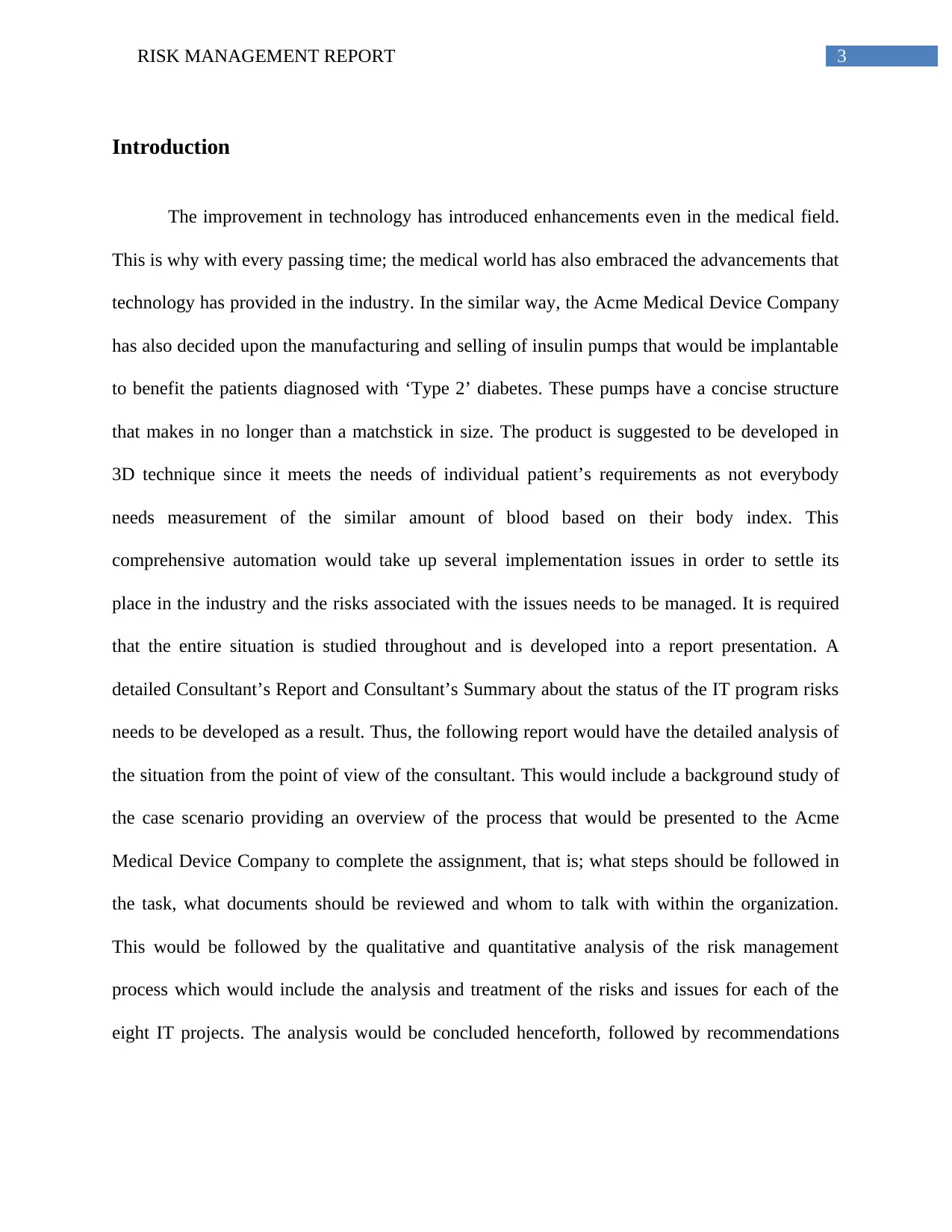
3RISK MANAGEMENT REPORT
Introduction
The improvement in technology has introduced enhancements even in the medical field.
This is why with every passing time; the medical world has also embraced the advancements that
technology has provided in the industry. In the similar way, the Acme Medical Device Company
has also decided upon the manufacturing and selling of insulin pumps that would be implantable
to benefit the patients diagnosed with ‘Type 2’ diabetes. These pumps have a concise structure
that makes in no longer than a matchstick in size. The product is suggested to be developed in
3D technique since it meets the needs of individual patient’s requirements as not everybody
needs measurement of the similar amount of blood based on their body index. This
comprehensive automation would take up several implementation issues in order to settle its
place in the industry and the risks associated with the issues needs to be managed. It is required
that the entire situation is studied throughout and is developed into a report presentation. A
detailed Consultant’s Report and Consultant’s Summary about the status of the IT program risks
needs to be developed as a result. Thus, the following report would have the detailed analysis of
the situation from the point of view of the consultant. This would include a background study of
the case scenario providing an overview of the process that would be presented to the Acme
Medical Device Company to complete the assignment, that is; what steps should be followed in
the task, what documents should be reviewed and whom to talk with within the organization.
This would be followed by the qualitative and quantitative analysis of the risk management
process which would include the analysis and treatment of the risks and issues for each of the
eight IT projects. The analysis would be concluded henceforth, followed by recommendations
Introduction
The improvement in technology has introduced enhancements even in the medical field.
This is why with every passing time; the medical world has also embraced the advancements that
technology has provided in the industry. In the similar way, the Acme Medical Device Company
has also decided upon the manufacturing and selling of insulin pumps that would be implantable
to benefit the patients diagnosed with ‘Type 2’ diabetes. These pumps have a concise structure
that makes in no longer than a matchstick in size. The product is suggested to be developed in
3D technique since it meets the needs of individual patient’s requirements as not everybody
needs measurement of the similar amount of blood based on their body index. This
comprehensive automation would take up several implementation issues in order to settle its
place in the industry and the risks associated with the issues needs to be managed. It is required
that the entire situation is studied throughout and is developed into a report presentation. A
detailed Consultant’s Report and Consultant’s Summary about the status of the IT program risks
needs to be developed as a result. Thus, the following report would have the detailed analysis of
the situation from the point of view of the consultant. This would include a background study of
the case scenario providing an overview of the process that would be presented to the Acme
Medical Device Company to complete the assignment, that is; what steps should be followed in
the task, what documents should be reviewed and whom to talk with within the organization.
This would be followed by the qualitative and quantitative analysis of the risk management
process which would include the analysis and treatment of the risks and issues for each of the
eight IT projects. The analysis would be concluded henceforth, followed by recommendations
Secure Best Marks with AI Grader
Need help grading? Try our AI Grader for instant feedback on your assignments.
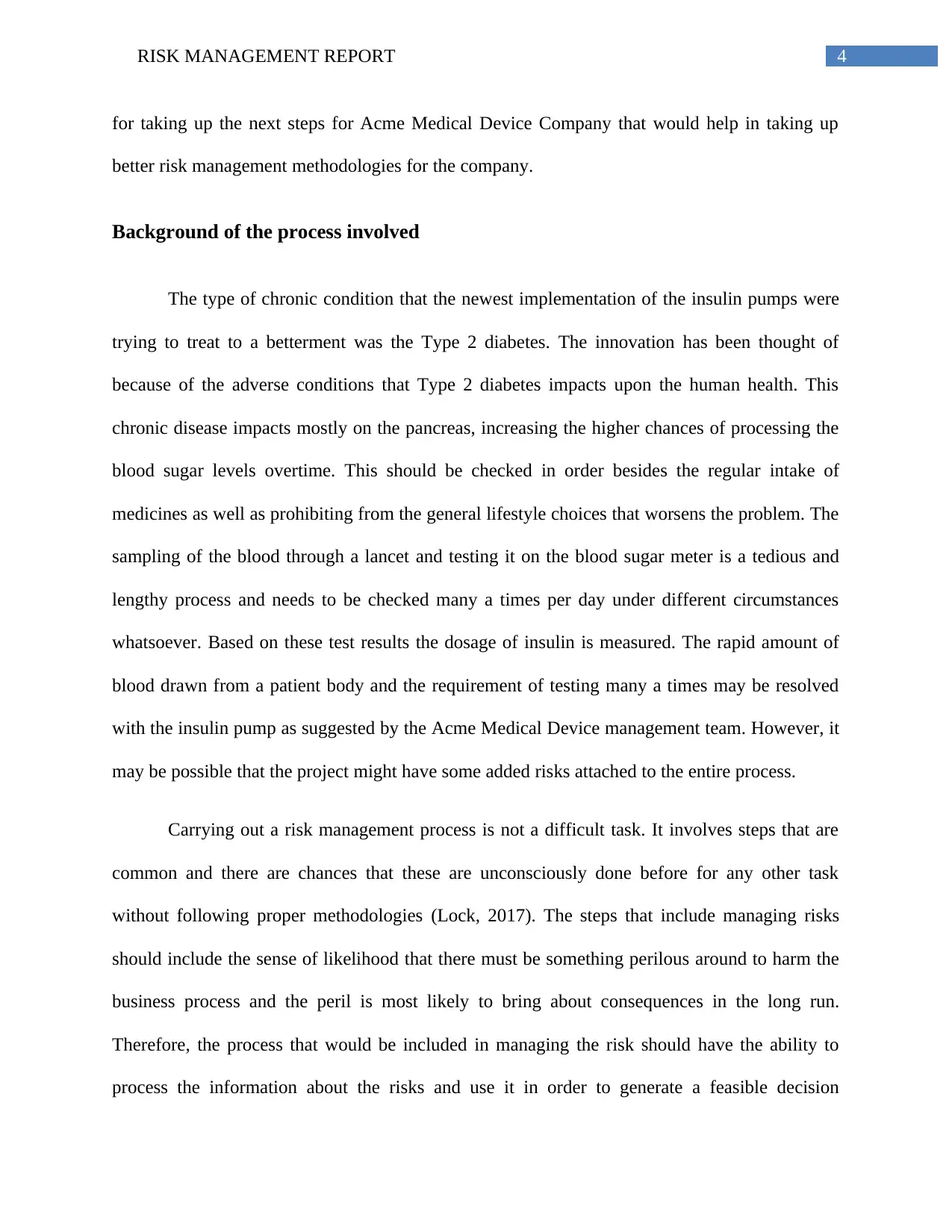
4RISK MANAGEMENT REPORT
for taking up the next steps for Acme Medical Device Company that would help in taking up
better risk management methodologies for the company.
Background of the process involved
The type of chronic condition that the newest implementation of the insulin pumps were
trying to treat to a betterment was the Type 2 diabetes. The innovation has been thought of
because of the adverse conditions that Type 2 diabetes impacts upon the human health. This
chronic disease impacts mostly on the pancreas, increasing the higher chances of processing the
blood sugar levels overtime. This should be checked in order besides the regular intake of
medicines as well as prohibiting from the general lifestyle choices that worsens the problem. The
sampling of the blood through a lancet and testing it on the blood sugar meter is a tedious and
lengthy process and needs to be checked many a times per day under different circumstances
whatsoever. Based on these test results the dosage of insulin is measured. The rapid amount of
blood drawn from a patient body and the requirement of testing many a times may be resolved
with the insulin pump as suggested by the Acme Medical Device management team. However, it
may be possible that the project might have some added risks attached to the entire process.
Carrying out a risk management process is not a difficult task. It involves steps that are
common and there are chances that these are unconsciously done before for any other task
without following proper methodologies (Lock, 2017). The steps that include managing risks
should include the sense of likelihood that there must be something perilous around to harm the
business process and the peril is most likely to bring about consequences in the long run.
Therefore, the process that would be included in managing the risk should have the ability to
process the information about the risks and use it in order to generate a feasible decision
for taking up the next steps for Acme Medical Device Company that would help in taking up
better risk management methodologies for the company.
Background of the process involved
The type of chronic condition that the newest implementation of the insulin pumps were
trying to treat to a betterment was the Type 2 diabetes. The innovation has been thought of
because of the adverse conditions that Type 2 diabetes impacts upon the human health. This
chronic disease impacts mostly on the pancreas, increasing the higher chances of processing the
blood sugar levels overtime. This should be checked in order besides the regular intake of
medicines as well as prohibiting from the general lifestyle choices that worsens the problem. The
sampling of the blood through a lancet and testing it on the blood sugar meter is a tedious and
lengthy process and needs to be checked many a times per day under different circumstances
whatsoever. Based on these test results the dosage of insulin is measured. The rapid amount of
blood drawn from a patient body and the requirement of testing many a times may be resolved
with the insulin pump as suggested by the Acme Medical Device management team. However, it
may be possible that the project might have some added risks attached to the entire process.
Carrying out a risk management process is not a difficult task. It involves steps that are
common and there are chances that these are unconsciously done before for any other task
without following proper methodologies (Lock, 2017). The steps that include managing risks
should include the sense of likelihood that there must be something perilous around to harm the
business process and the peril is most likely to bring about consequences in the long run.
Therefore, the process that would be included in managing the risk should have the ability to
process the information about the risks and use it in order to generate a feasible decision
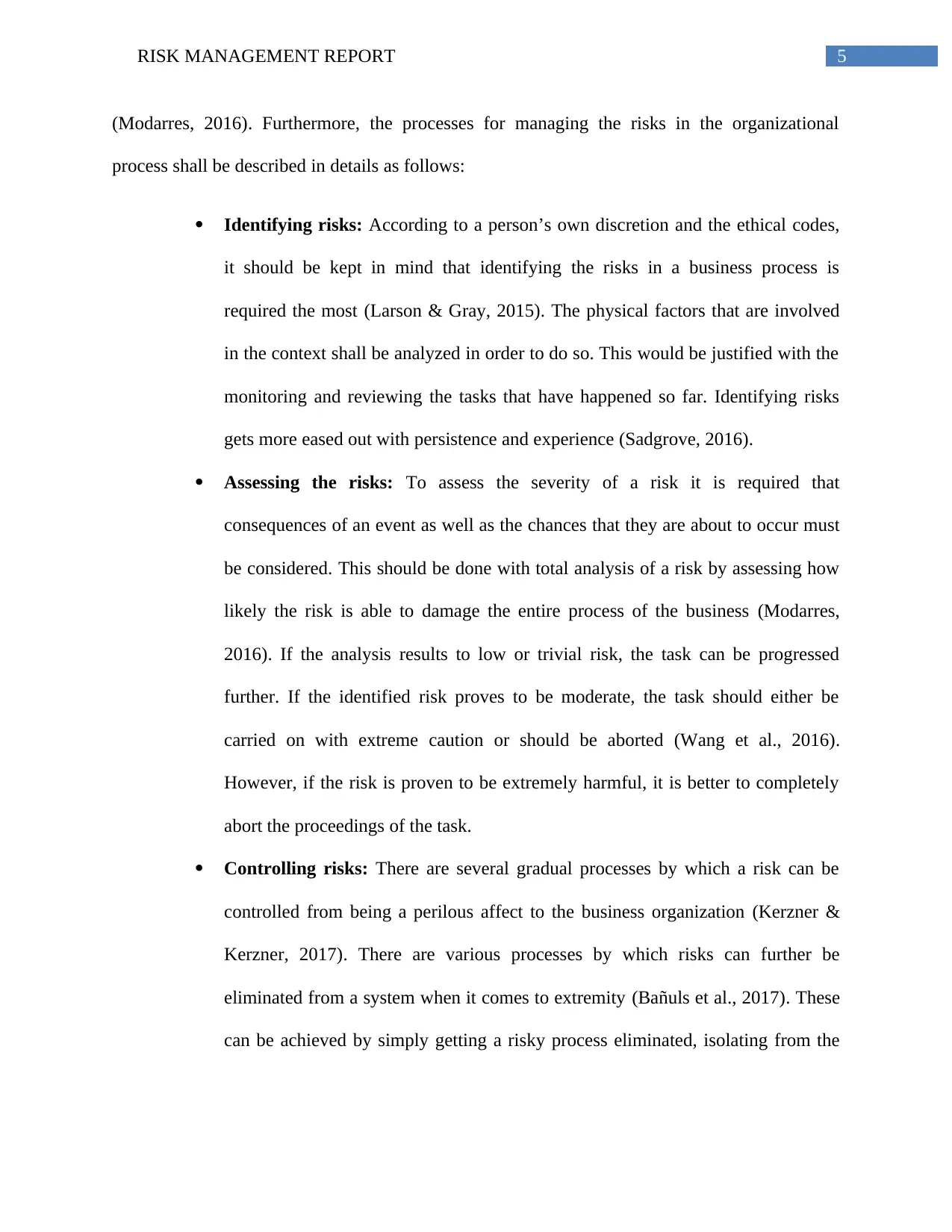
5RISK MANAGEMENT REPORT
(Modarres, 2016). Furthermore, the processes for managing the risks in the organizational
process shall be described in details as follows:
Identifying risks: According to a person’s own discretion and the ethical codes,
it should be kept in mind that identifying the risks in a business process is
required the most (Larson & Gray, 2015). The physical factors that are involved
in the context shall be analyzed in order to do so. This would be justified with the
monitoring and reviewing the tasks that have happened so far. Identifying risks
gets more eased out with persistence and experience (Sadgrove, 2016).
Assessing the risks: To assess the severity of a risk it is required that
consequences of an event as well as the chances that they are about to occur must
be considered. This should be done with total analysis of a risk by assessing how
likely the risk is able to damage the entire process of the business (Modarres,
2016). If the analysis results to low or trivial risk, the task can be progressed
further. If the identified risk proves to be moderate, the task should either be
carried on with extreme caution or should be aborted (Wang et al., 2016).
However, if the risk is proven to be extremely harmful, it is better to completely
abort the proceedings of the task.
Controlling risks: There are several gradual processes by which a risk can be
controlled from being a perilous affect to the business organization (Kerzner &
Kerzner, 2017). There are various processes by which risks can further be
eliminated from a system when it comes to extremity (Bañuls et al., 2017). These
can be achieved by simply getting a risky process eliminated, isolating from the
(Modarres, 2016). Furthermore, the processes for managing the risks in the organizational
process shall be described in details as follows:
Identifying risks: According to a person’s own discretion and the ethical codes,
it should be kept in mind that identifying the risks in a business process is
required the most (Larson & Gray, 2015). The physical factors that are involved
in the context shall be analyzed in order to do so. This would be justified with the
monitoring and reviewing the tasks that have happened so far. Identifying risks
gets more eased out with persistence and experience (Sadgrove, 2016).
Assessing the risks: To assess the severity of a risk it is required that
consequences of an event as well as the chances that they are about to occur must
be considered. This should be done with total analysis of a risk by assessing how
likely the risk is able to damage the entire process of the business (Modarres,
2016). If the analysis results to low or trivial risk, the task can be progressed
further. If the identified risk proves to be moderate, the task should either be
carried on with extreme caution or should be aborted (Wang et al., 2016).
However, if the risk is proven to be extremely harmful, it is better to completely
abort the proceedings of the task.
Controlling risks: There are several gradual processes by which a risk can be
controlled from being a perilous affect to the business organization (Kerzner &
Kerzner, 2017). There are various processes by which risks can further be
eliminated from a system when it comes to extremity (Bañuls et al., 2017). These
can be achieved by simply getting a risky process eliminated, isolating from the
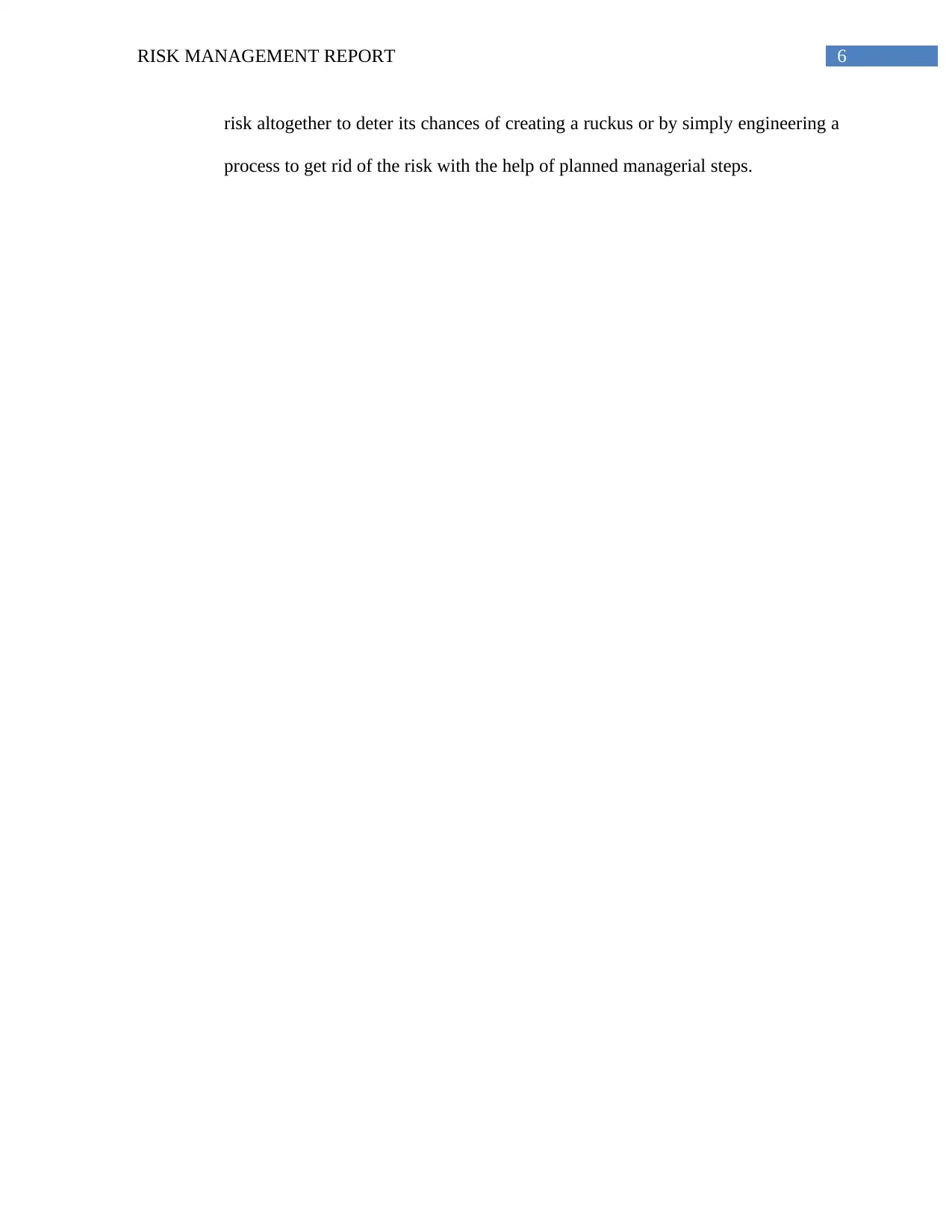
6RISK MANAGEMENT REPORT
risk altogether to deter its chances of creating a ruckus or by simply engineering a
process to get rid of the risk with the help of planned managerial steps.
risk altogether to deter its chances of creating a ruckus or by simply engineering a
process to get rid of the risk with the help of planned managerial steps.
Paraphrase This Document
Need a fresh take? Get an instant paraphrase of this document with our AI Paraphraser
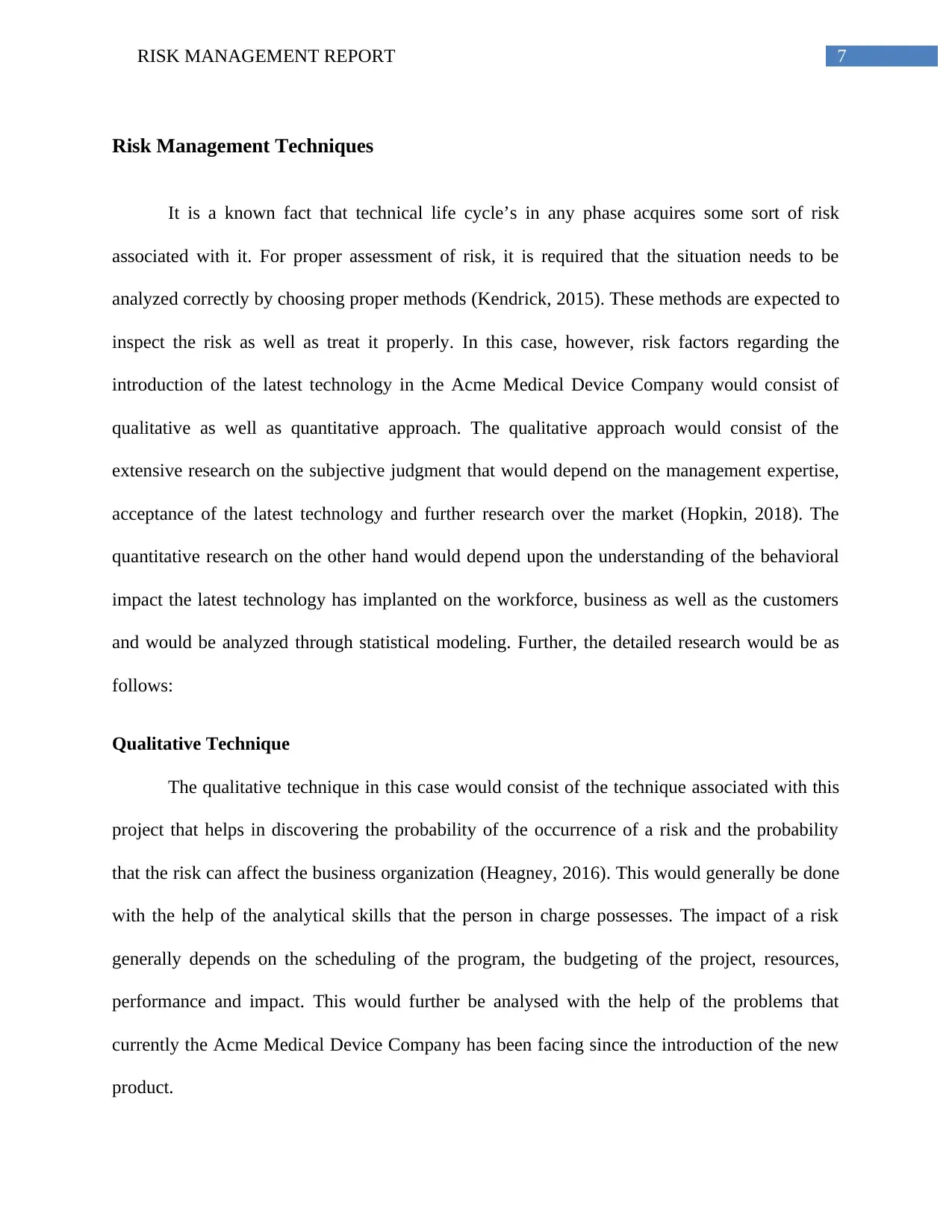
7RISK MANAGEMENT REPORT
Risk Management Techniques
It is a known fact that technical life cycle’s in any phase acquires some sort of risk
associated with it. For proper assessment of risk, it is required that the situation needs to be
analyzed correctly by choosing proper methods (Kendrick, 2015). These methods are expected to
inspect the risk as well as treat it properly. In this case, however, risk factors regarding the
introduction of the latest technology in the Acme Medical Device Company would consist of
qualitative as well as quantitative approach. The qualitative approach would consist of the
extensive research on the subjective judgment that would depend on the management expertise,
acceptance of the latest technology and further research over the market (Hopkin, 2018). The
quantitative research on the other hand would depend upon the understanding of the behavioral
impact the latest technology has implanted on the workforce, business as well as the customers
and would be analyzed through statistical modeling. Further, the detailed research would be as
follows:
Qualitative Technique
The qualitative technique in this case would consist of the technique associated with this
project that helps in discovering the probability of the occurrence of a risk and the probability
that the risk can affect the business organization (Heagney, 2016). This would generally be done
with the help of the analytical skills that the person in charge possesses. The impact of a risk
generally depends on the scheduling of the program, the budgeting of the project, resources,
performance and impact. This would further be analysed with the help of the problems that
currently the Acme Medical Device Company has been facing since the introduction of the new
product.
Risk Management Techniques
It is a known fact that technical life cycle’s in any phase acquires some sort of risk
associated with it. For proper assessment of risk, it is required that the situation needs to be
analyzed correctly by choosing proper methods (Kendrick, 2015). These methods are expected to
inspect the risk as well as treat it properly. In this case, however, risk factors regarding the
introduction of the latest technology in the Acme Medical Device Company would consist of
qualitative as well as quantitative approach. The qualitative approach would consist of the
extensive research on the subjective judgment that would depend on the management expertise,
acceptance of the latest technology and further research over the market (Hopkin, 2018). The
quantitative research on the other hand would depend upon the understanding of the behavioral
impact the latest technology has implanted on the workforce, business as well as the customers
and would be analyzed through statistical modeling. Further, the detailed research would be as
follows:
Qualitative Technique
The qualitative technique in this case would consist of the technique associated with this
project that helps in discovering the probability of the occurrence of a risk and the probability
that the risk can affect the business organization (Heagney, 2016). This would generally be done
with the help of the analytical skills that the person in charge possesses. The impact of a risk
generally depends on the scheduling of the program, the budgeting of the project, resources,
performance and impact. This would further be analysed with the help of the problems that
currently the Acme Medical Device Company has been facing since the introduction of the new
product.
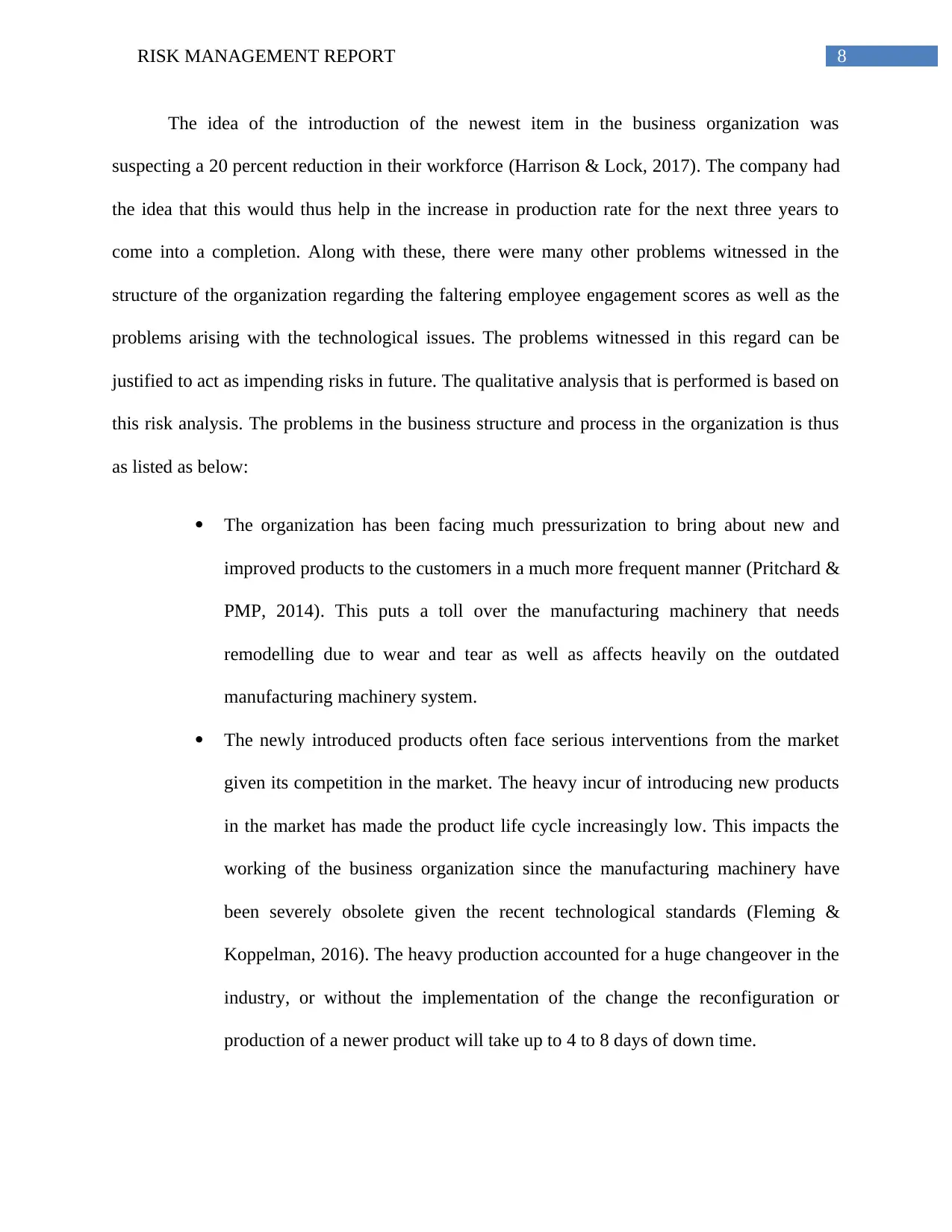
8RISK MANAGEMENT REPORT
The idea of the introduction of the newest item in the business organization was
suspecting a 20 percent reduction in their workforce (Harrison & Lock, 2017). The company had
the idea that this would thus help in the increase in production rate for the next three years to
come into a completion. Along with these, there were many other problems witnessed in the
structure of the organization regarding the faltering employee engagement scores as well as the
problems arising with the technological issues. The problems witnessed in this regard can be
justified to act as impending risks in future. The qualitative analysis that is performed is based on
this risk analysis. The problems in the business structure and process in the organization is thus
as listed as below:
The organization has been facing much pressurization to bring about new and
improved products to the customers in a much more frequent manner (Pritchard &
PMP, 2014). This puts a toll over the manufacturing machinery that needs
remodelling due to wear and tear as well as affects heavily on the outdated
manufacturing machinery system.
The newly introduced products often face serious interventions from the market
given its competition in the market. The heavy incur of introducing new products
in the market has made the product life cycle increasingly low. This impacts the
working of the business organization since the manufacturing machinery have
been severely obsolete given the recent technological standards (Fleming &
Koppelman, 2016). The heavy production accounted for a huge changeover in the
industry, or without the implementation of the change the reconfiguration or
production of a newer product will take up to 4 to 8 days of down time.
The idea of the introduction of the newest item in the business organization was
suspecting a 20 percent reduction in their workforce (Harrison & Lock, 2017). The company had
the idea that this would thus help in the increase in production rate for the next three years to
come into a completion. Along with these, there were many other problems witnessed in the
structure of the organization regarding the faltering employee engagement scores as well as the
problems arising with the technological issues. The problems witnessed in this regard can be
justified to act as impending risks in future. The qualitative analysis that is performed is based on
this risk analysis. The problems in the business structure and process in the organization is thus
as listed as below:
The organization has been facing much pressurization to bring about new and
improved products to the customers in a much more frequent manner (Pritchard &
PMP, 2014). This puts a toll over the manufacturing machinery that needs
remodelling due to wear and tear as well as affects heavily on the outdated
manufacturing machinery system.
The newly introduced products often face serious interventions from the market
given its competition in the market. The heavy incur of introducing new products
in the market has made the product life cycle increasingly low. This impacts the
working of the business organization since the manufacturing machinery have
been severely obsolete given the recent technological standards (Fleming &
Koppelman, 2016). The heavy production accounted for a huge changeover in the
industry, or without the implementation of the change the reconfiguration or
production of a newer product will take up to 4 to 8 days of down time.
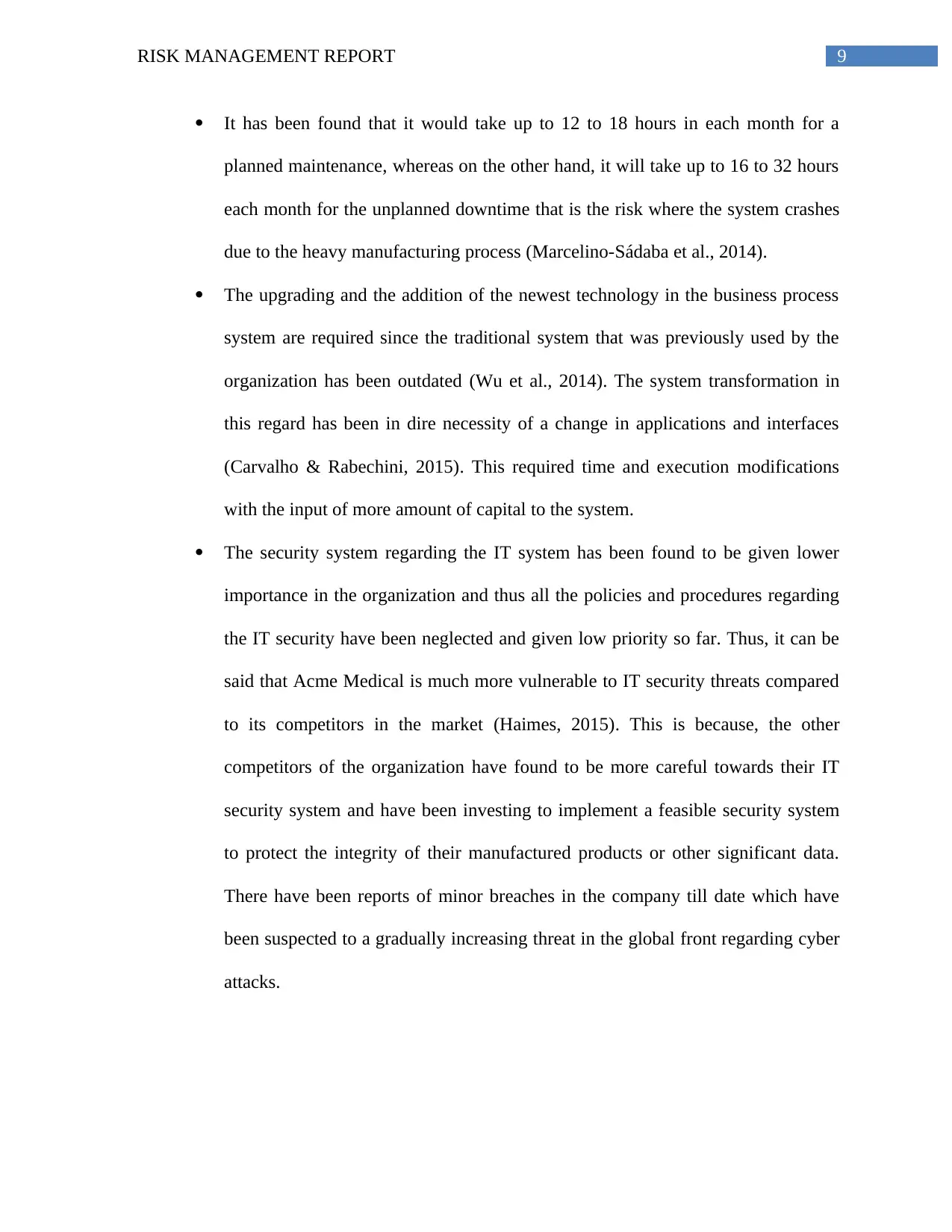
9RISK MANAGEMENT REPORT
It has been found that it would take up to 12 to 18 hours in each month for a
planned maintenance, whereas on the other hand, it will take up to 16 to 32 hours
each month for the unplanned downtime that is the risk where the system crashes
due to the heavy manufacturing process (Marcelino-Sádaba et al., 2014).
The upgrading and the addition of the newest technology in the business process
system are required since the traditional system that was previously used by the
organization has been outdated (Wu et al., 2014). The system transformation in
this regard has been in dire necessity of a change in applications and interfaces
(Carvalho & Rabechini, 2015). This required time and execution modifications
with the input of more amount of capital to the system.
The security system regarding the IT system has been found to be given lower
importance in the organization and thus all the policies and procedures regarding
the IT security have been neglected and given low priority so far. Thus, it can be
said that Acme Medical is much more vulnerable to IT security threats compared
to its competitors in the market (Haimes, 2015). This is because, the other
competitors of the organization have found to be more careful towards their IT
security system and have been investing to implement a feasible security system
to protect the integrity of their manufactured products or other significant data.
There have been reports of minor breaches in the company till date which have
been suspected to a gradually increasing threat in the global front regarding cyber
attacks.
It has been found that it would take up to 12 to 18 hours in each month for a
planned maintenance, whereas on the other hand, it will take up to 16 to 32 hours
each month for the unplanned downtime that is the risk where the system crashes
due to the heavy manufacturing process (Marcelino-Sádaba et al., 2014).
The upgrading and the addition of the newest technology in the business process
system are required since the traditional system that was previously used by the
organization has been outdated (Wu et al., 2014). The system transformation in
this regard has been in dire necessity of a change in applications and interfaces
(Carvalho & Rabechini, 2015). This required time and execution modifications
with the input of more amount of capital to the system.
The security system regarding the IT system has been found to be given lower
importance in the organization and thus all the policies and procedures regarding
the IT security have been neglected and given low priority so far. Thus, it can be
said that Acme Medical is much more vulnerable to IT security threats compared
to its competitors in the market (Haimes, 2015). This is because, the other
competitors of the organization have found to be more careful towards their IT
security system and have been investing to implement a feasible security system
to protect the integrity of their manufactured products or other significant data.
There have been reports of minor breaches in the company till date which have
been suspected to a gradually increasing threat in the global front regarding cyber
attacks.
Secure Best Marks with AI Grader
Need help grading? Try our AI Grader for instant feedback on your assignments.
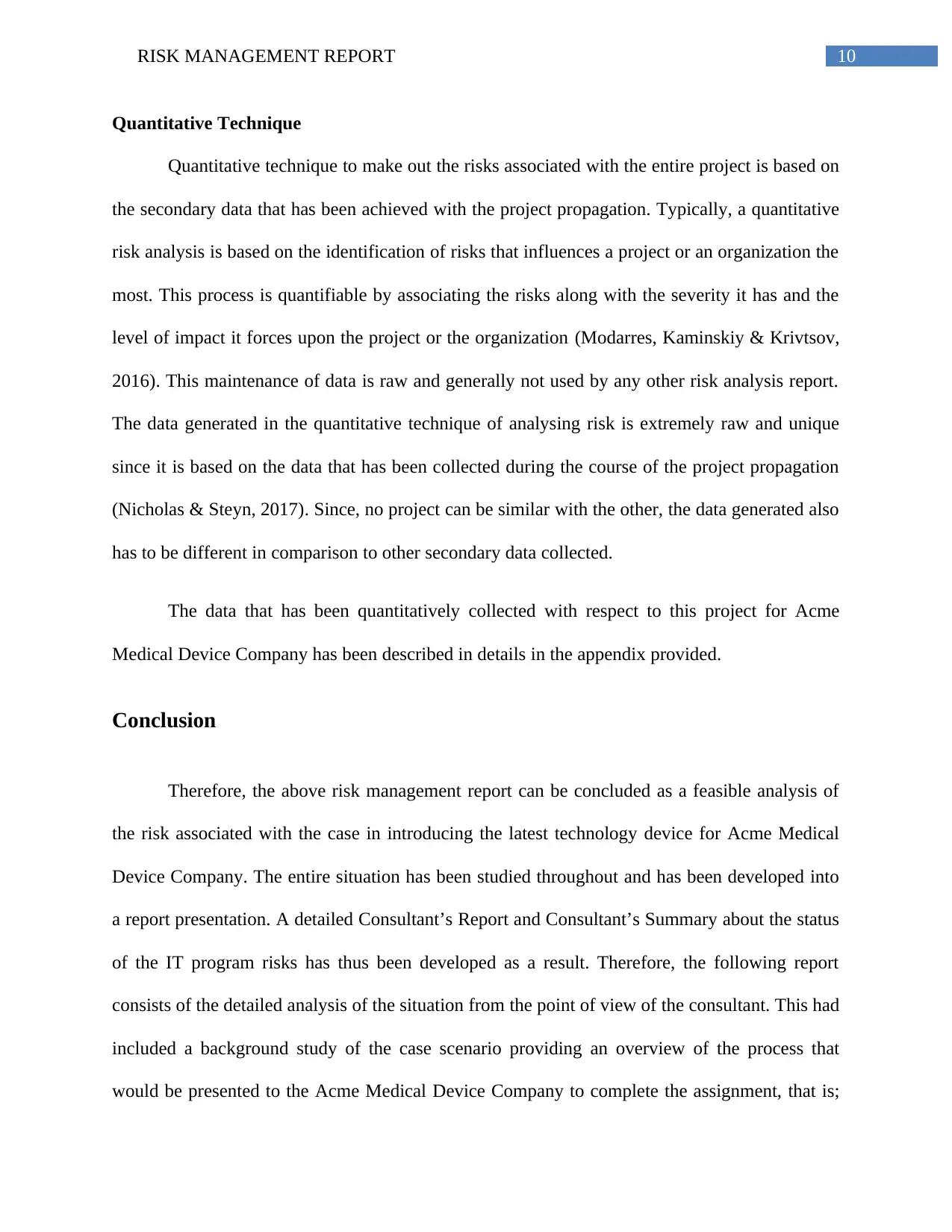
10RISK MANAGEMENT REPORT
Quantitative Technique
Quantitative technique to make out the risks associated with the entire project is based on
the secondary data that has been achieved with the project propagation. Typically, a quantitative
risk analysis is based on the identification of risks that influences a project or an organization the
most. This process is quantifiable by associating the risks along with the severity it has and the
level of impact it forces upon the project or the organization (Modarres, Kaminskiy & Krivtsov,
2016). This maintenance of data is raw and generally not used by any other risk analysis report.
The data generated in the quantitative technique of analysing risk is extremely raw and unique
since it is based on the data that has been collected during the course of the project propagation
(Nicholas & Steyn, 2017). Since, no project can be similar with the other, the data generated also
has to be different in comparison to other secondary data collected.
The data that has been quantitatively collected with respect to this project for Acme
Medical Device Company has been described in details in the appendix provided.
Conclusion
Therefore, the above risk management report can be concluded as a feasible analysis of
the risk associated with the case in introducing the latest technology device for Acme Medical
Device Company. The entire situation has been studied throughout and has been developed into
a report presentation. A detailed Consultant’s Report and Consultant’s Summary about the status
of the IT program risks has thus been developed as a result. Therefore, the following report
consists of the detailed analysis of the situation from the point of view of the consultant. This had
included a background study of the case scenario providing an overview of the process that
would be presented to the Acme Medical Device Company to complete the assignment, that is;
Quantitative Technique
Quantitative technique to make out the risks associated with the entire project is based on
the secondary data that has been achieved with the project propagation. Typically, a quantitative
risk analysis is based on the identification of risks that influences a project or an organization the
most. This process is quantifiable by associating the risks along with the severity it has and the
level of impact it forces upon the project or the organization (Modarres, Kaminskiy & Krivtsov,
2016). This maintenance of data is raw and generally not used by any other risk analysis report.
The data generated in the quantitative technique of analysing risk is extremely raw and unique
since it is based on the data that has been collected during the course of the project propagation
(Nicholas & Steyn, 2017). Since, no project can be similar with the other, the data generated also
has to be different in comparison to other secondary data collected.
The data that has been quantitatively collected with respect to this project for Acme
Medical Device Company has been described in details in the appendix provided.
Conclusion
Therefore, the above risk management report can be concluded as a feasible analysis of
the risk associated with the case in introducing the latest technology device for Acme Medical
Device Company. The entire situation has been studied throughout and has been developed into
a report presentation. A detailed Consultant’s Report and Consultant’s Summary about the status
of the IT program risks has thus been developed as a result. Therefore, the following report
consists of the detailed analysis of the situation from the point of view of the consultant. This had
included a background study of the case scenario providing an overview of the process that
would be presented to the Acme Medical Device Company to complete the assignment, that is;
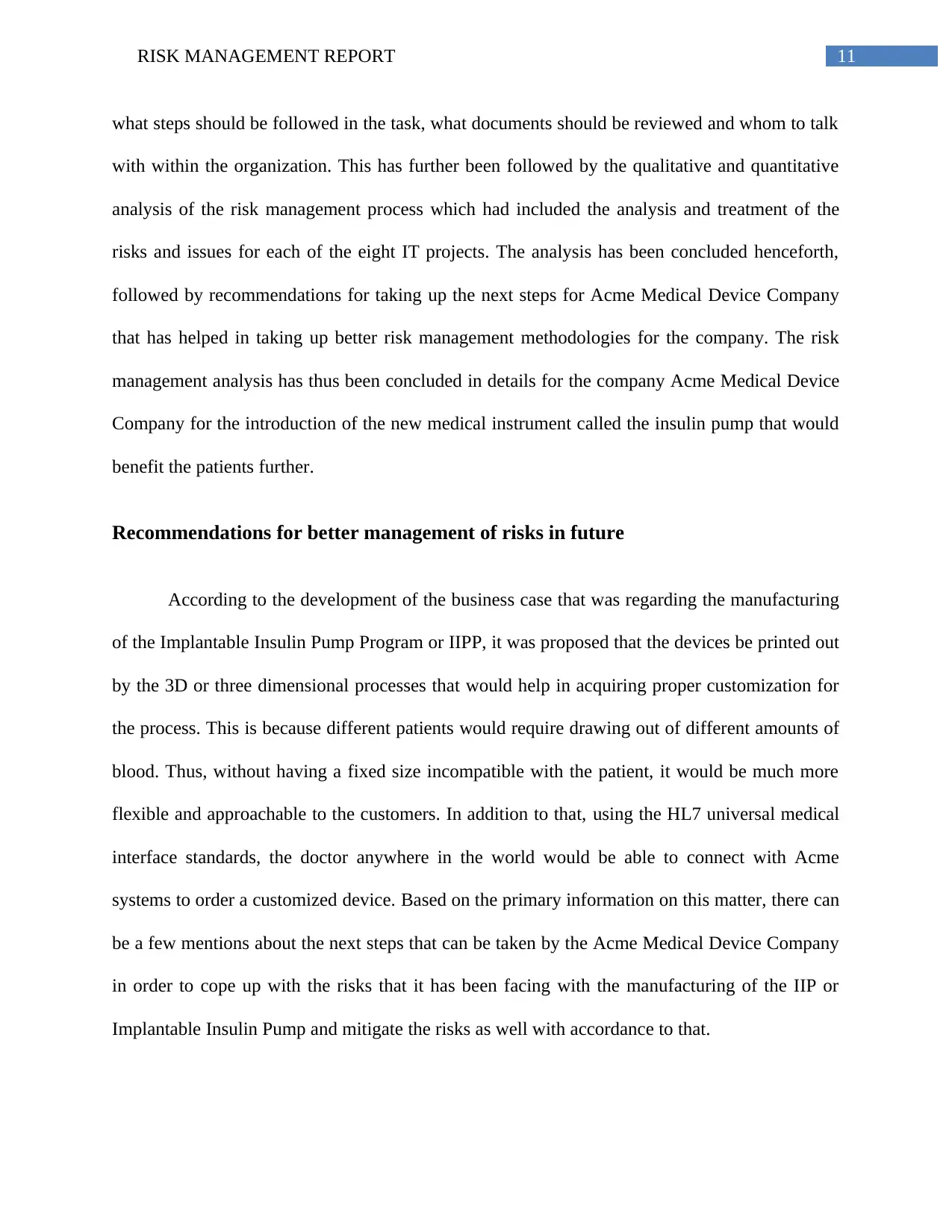
11RISK MANAGEMENT REPORT
what steps should be followed in the task, what documents should be reviewed and whom to talk
with within the organization. This has further been followed by the qualitative and quantitative
analysis of the risk management process which had included the analysis and treatment of the
risks and issues for each of the eight IT projects. The analysis has been concluded henceforth,
followed by recommendations for taking up the next steps for Acme Medical Device Company
that has helped in taking up better risk management methodologies for the company. The risk
management analysis has thus been concluded in details for the company Acme Medical Device
Company for the introduction of the new medical instrument called the insulin pump that would
benefit the patients further.
Recommendations for better management of risks in future
According to the development of the business case that was regarding the manufacturing
of the Implantable Insulin Pump Program or IIPP, it was proposed that the devices be printed out
by the 3D or three dimensional processes that would help in acquiring proper customization for
the process. This is because different patients would require drawing out of different amounts of
blood. Thus, without having a fixed size incompatible with the patient, it would be much more
flexible and approachable to the customers. In addition to that, using the HL7 universal medical
interface standards, the doctor anywhere in the world would be able to connect with Acme
systems to order a customized device. Based on the primary information on this matter, there can
be a few mentions about the next steps that can be taken by the Acme Medical Device Company
in order to cope up with the risks that it has been facing with the manufacturing of the IIP or
Implantable Insulin Pump and mitigate the risks as well with accordance to that.
what steps should be followed in the task, what documents should be reviewed and whom to talk
with within the organization. This has further been followed by the qualitative and quantitative
analysis of the risk management process which had included the analysis and treatment of the
risks and issues for each of the eight IT projects. The analysis has been concluded henceforth,
followed by recommendations for taking up the next steps for Acme Medical Device Company
that has helped in taking up better risk management methodologies for the company. The risk
management analysis has thus been concluded in details for the company Acme Medical Device
Company for the introduction of the new medical instrument called the insulin pump that would
benefit the patients further.
Recommendations for better management of risks in future
According to the development of the business case that was regarding the manufacturing
of the Implantable Insulin Pump Program or IIPP, it was proposed that the devices be printed out
by the 3D or three dimensional processes that would help in acquiring proper customization for
the process. This is because different patients would require drawing out of different amounts of
blood. Thus, without having a fixed size incompatible with the patient, it would be much more
flexible and approachable to the customers. In addition to that, using the HL7 universal medical
interface standards, the doctor anywhere in the world would be able to connect with Acme
systems to order a customized device. Based on the primary information on this matter, there can
be a few mentions about the next steps that can be taken by the Acme Medical Device Company
in order to cope up with the risks that it has been facing with the manufacturing of the IIP or
Implantable Insulin Pump and mitigate the risks as well with accordance to that.
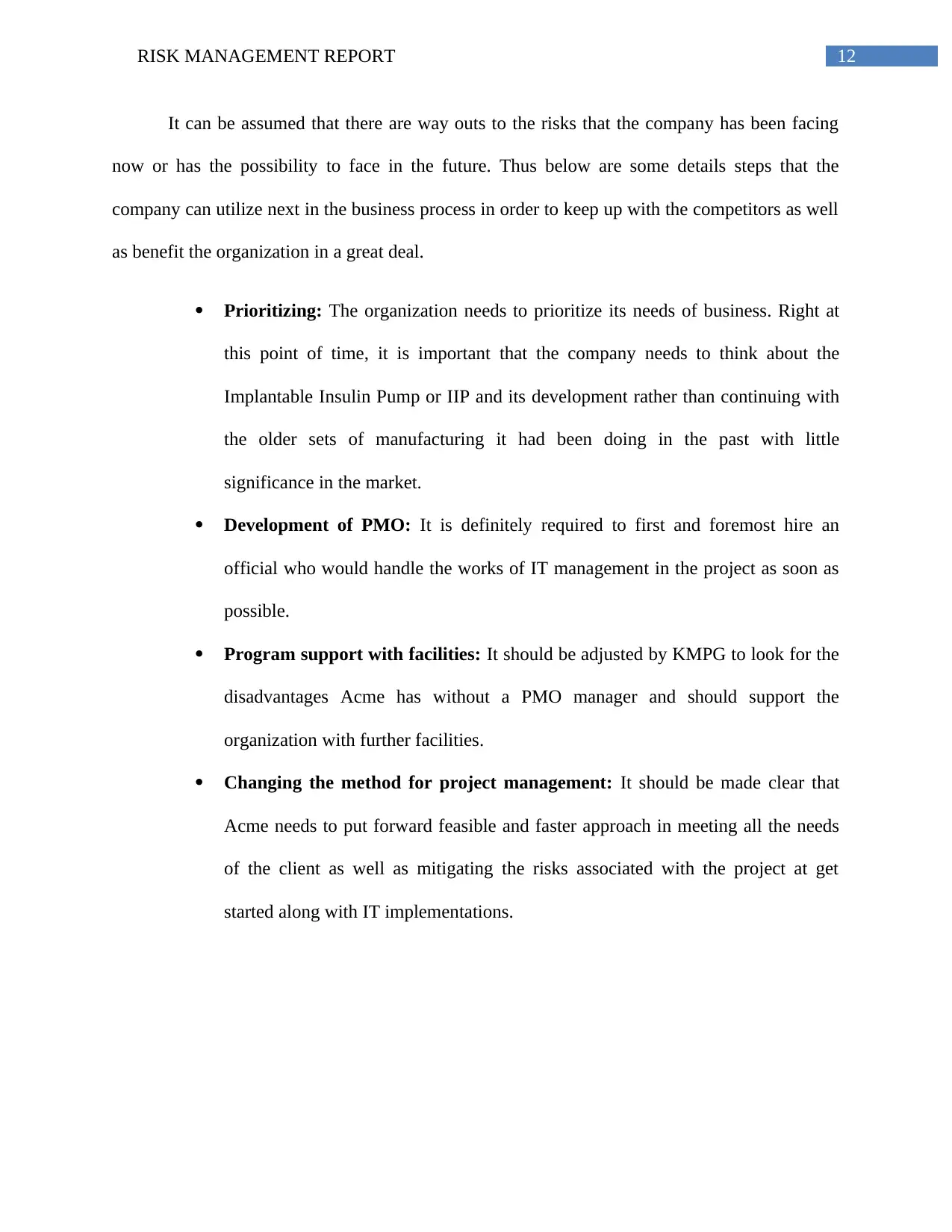
12RISK MANAGEMENT REPORT
It can be assumed that there are way outs to the risks that the company has been facing
now or has the possibility to face in the future. Thus below are some details steps that the
company can utilize next in the business process in order to keep up with the competitors as well
as benefit the organization in a great deal.
Prioritizing: The organization needs to prioritize its needs of business. Right at
this point of time, it is important that the company needs to think about the
Implantable Insulin Pump or IIP and its development rather than continuing with
the older sets of manufacturing it had been doing in the past with little
significance in the market.
Development of PMO: It is definitely required to first and foremost hire an
official who would handle the works of IT management in the project as soon as
possible.
Program support with facilities: It should be adjusted by KMPG to look for the
disadvantages Acme has without a PMO manager and should support the
organization with further facilities.
Changing the method for project management: It should be made clear that
Acme needs to put forward feasible and faster approach in meeting all the needs
of the client as well as mitigating the risks associated with the project at get
started along with IT implementations.
It can be assumed that there are way outs to the risks that the company has been facing
now or has the possibility to face in the future. Thus below are some details steps that the
company can utilize next in the business process in order to keep up with the competitors as well
as benefit the organization in a great deal.
Prioritizing: The organization needs to prioritize its needs of business. Right at
this point of time, it is important that the company needs to think about the
Implantable Insulin Pump or IIP and its development rather than continuing with
the older sets of manufacturing it had been doing in the past with little
significance in the market.
Development of PMO: It is definitely required to first and foremost hire an
official who would handle the works of IT management in the project as soon as
possible.
Program support with facilities: It should be adjusted by KMPG to look for the
disadvantages Acme has without a PMO manager and should support the
organization with further facilities.
Changing the method for project management: It should be made clear that
Acme needs to put forward feasible and faster approach in meeting all the needs
of the client as well as mitigating the risks associated with the project at get
started along with IT implementations.
Paraphrase This Document
Need a fresh take? Get an instant paraphrase of this document with our AI Paraphraser
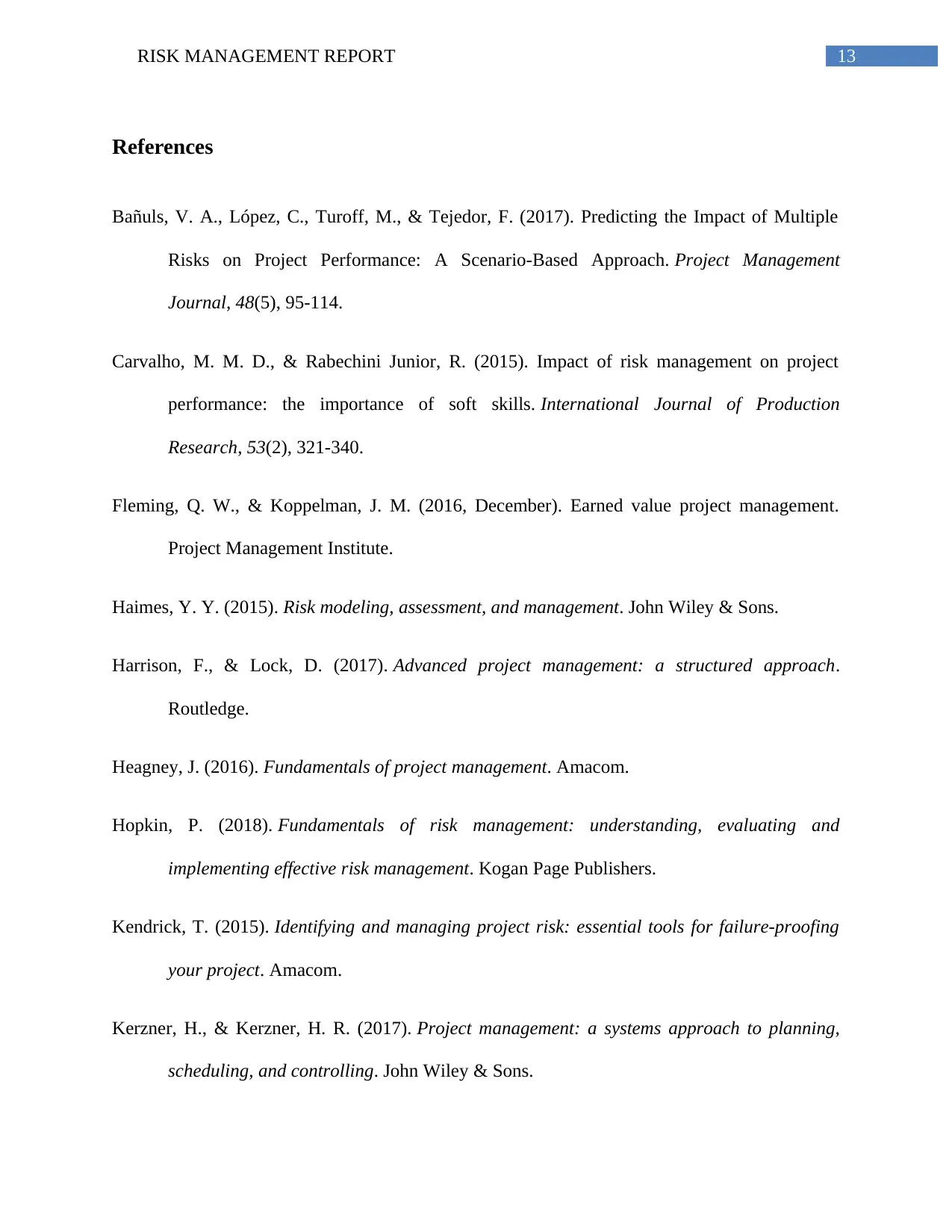
13RISK MANAGEMENT REPORT
References
Bañuls, V. A., López, C., Turoff, M., & Tejedor, F. (2017). Predicting the Impact of Multiple
Risks on Project Performance: A Scenario-Based Approach. Project Management
Journal, 48(5), 95-114.
Carvalho, M. M. D., & Rabechini Junior, R. (2015). Impact of risk management on project
performance: the importance of soft skills. International Journal of Production
Research, 53(2), 321-340.
Fleming, Q. W., & Koppelman, J. M. (2016, December). Earned value project management.
Project Management Institute.
Haimes, Y. Y. (2015). Risk modeling, assessment, and management. John Wiley & Sons.
Harrison, F., & Lock, D. (2017). Advanced project management: a structured approach.
Routledge.
Heagney, J. (2016). Fundamentals of project management. Amacom.
Hopkin, P. (2018). Fundamentals of risk management: understanding, evaluating and
implementing effective risk management. Kogan Page Publishers.
Kendrick, T. (2015). Identifying and managing project risk: essential tools for failure-proofing
your project. Amacom.
Kerzner, H., & Kerzner, H. R. (2017). Project management: a systems approach to planning,
scheduling, and controlling. John Wiley & Sons.
References
Bañuls, V. A., López, C., Turoff, M., & Tejedor, F. (2017). Predicting the Impact of Multiple
Risks on Project Performance: A Scenario-Based Approach. Project Management
Journal, 48(5), 95-114.
Carvalho, M. M. D., & Rabechini Junior, R. (2015). Impact of risk management on project
performance: the importance of soft skills. International Journal of Production
Research, 53(2), 321-340.
Fleming, Q. W., & Koppelman, J. M. (2016, December). Earned value project management.
Project Management Institute.
Haimes, Y. Y. (2015). Risk modeling, assessment, and management. John Wiley & Sons.
Harrison, F., & Lock, D. (2017). Advanced project management: a structured approach.
Routledge.
Heagney, J. (2016). Fundamentals of project management. Amacom.
Hopkin, P. (2018). Fundamentals of risk management: understanding, evaluating and
implementing effective risk management. Kogan Page Publishers.
Kendrick, T. (2015). Identifying and managing project risk: essential tools for failure-proofing
your project. Amacom.
Kerzner, H., & Kerzner, H. R. (2017). Project management: a systems approach to planning,
scheduling, and controlling. John Wiley & Sons.
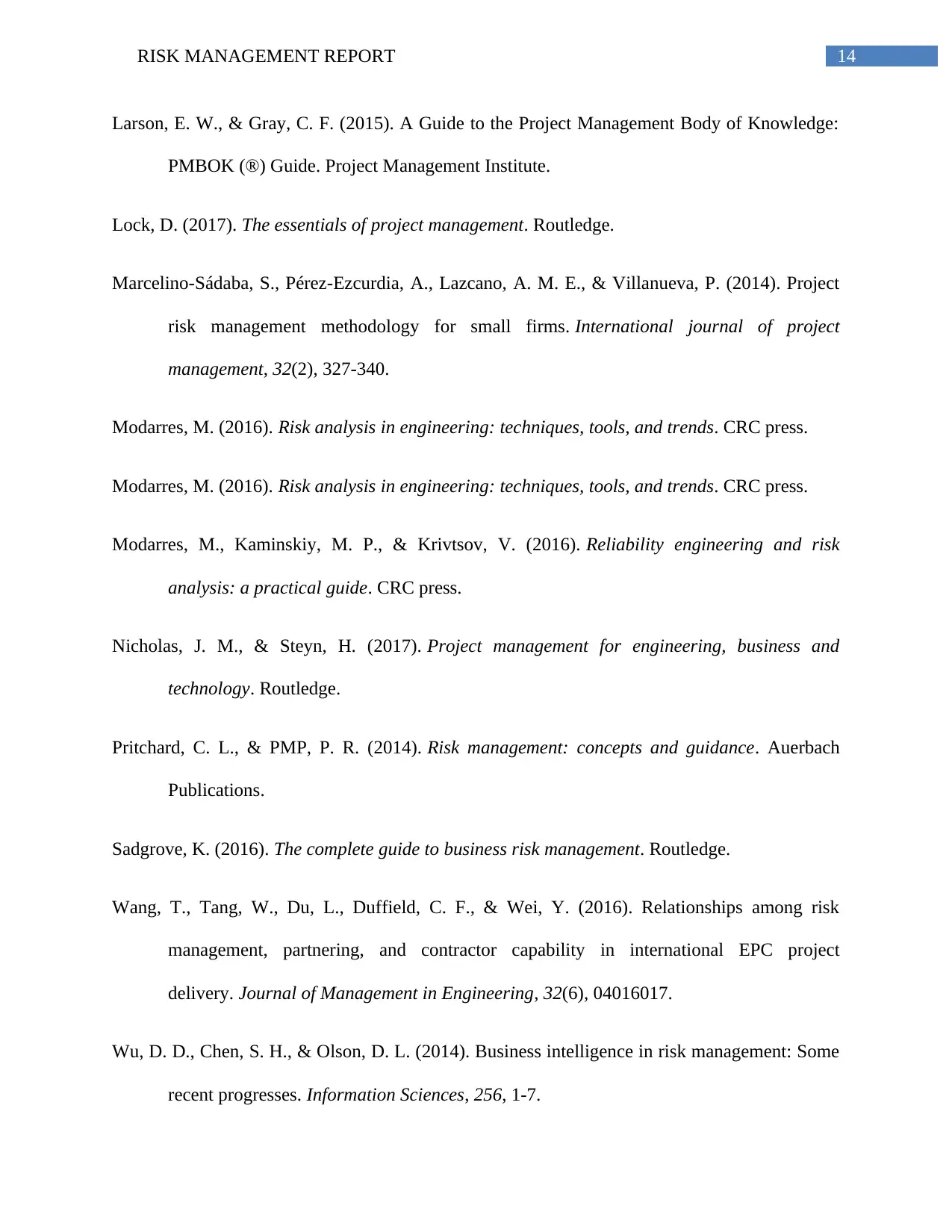
14RISK MANAGEMENT REPORT
Larson, E. W., & Gray, C. F. (2015). A Guide to the Project Management Body of Knowledge:
PMBOK (®) Guide. Project Management Institute.
Lock, D. (2017). The essentials of project management. Routledge.
Marcelino-Sádaba, S., Pérez-Ezcurdia, A., Lazcano, A. M. E., & Villanueva, P. (2014). Project
risk management methodology for small firms. International journal of project
management, 32(2), 327-340.
Modarres, M. (2016). Risk analysis in engineering: techniques, tools, and trends. CRC press.
Modarres, M. (2016). Risk analysis in engineering: techniques, tools, and trends. CRC press.
Modarres, M., Kaminskiy, M. P., & Krivtsov, V. (2016). Reliability engineering and risk
analysis: a practical guide. CRC press.
Nicholas, J. M., & Steyn, H. (2017). Project management for engineering, business and
technology. Routledge.
Pritchard, C. L., & PMP, P. R. (2014). Risk management: concepts and guidance. Auerbach
Publications.
Sadgrove, K. (2016). The complete guide to business risk management. Routledge.
Wang, T., Tang, W., Du, L., Duffield, C. F., & Wei, Y. (2016). Relationships among risk
management, partnering, and contractor capability in international EPC project
delivery. Journal of Management in Engineering, 32(6), 04016017.
Wu, D. D., Chen, S. H., & Olson, D. L. (2014). Business intelligence in risk management: Some
recent progresses. Information Sciences, 256, 1-7.
Larson, E. W., & Gray, C. F. (2015). A Guide to the Project Management Body of Knowledge:
PMBOK (®) Guide. Project Management Institute.
Lock, D. (2017). The essentials of project management. Routledge.
Marcelino-Sádaba, S., Pérez-Ezcurdia, A., Lazcano, A. M. E., & Villanueva, P. (2014). Project
risk management methodology for small firms. International journal of project
management, 32(2), 327-340.
Modarres, M. (2016). Risk analysis in engineering: techniques, tools, and trends. CRC press.
Modarres, M. (2016). Risk analysis in engineering: techniques, tools, and trends. CRC press.
Modarres, M., Kaminskiy, M. P., & Krivtsov, V. (2016). Reliability engineering and risk
analysis: a practical guide. CRC press.
Nicholas, J. M., & Steyn, H. (2017). Project management for engineering, business and
technology. Routledge.
Pritchard, C. L., & PMP, P. R. (2014). Risk management: concepts and guidance. Auerbach
Publications.
Sadgrove, K. (2016). The complete guide to business risk management. Routledge.
Wang, T., Tang, W., Du, L., Duffield, C. F., & Wei, Y. (2016). Relationships among risk
management, partnering, and contractor capability in international EPC project
delivery. Journal of Management in Engineering, 32(6), 04016017.
Wu, D. D., Chen, S. H., & Olson, D. L. (2014). Business intelligence in risk management: Some
recent progresses. Information Sciences, 256, 1-7.
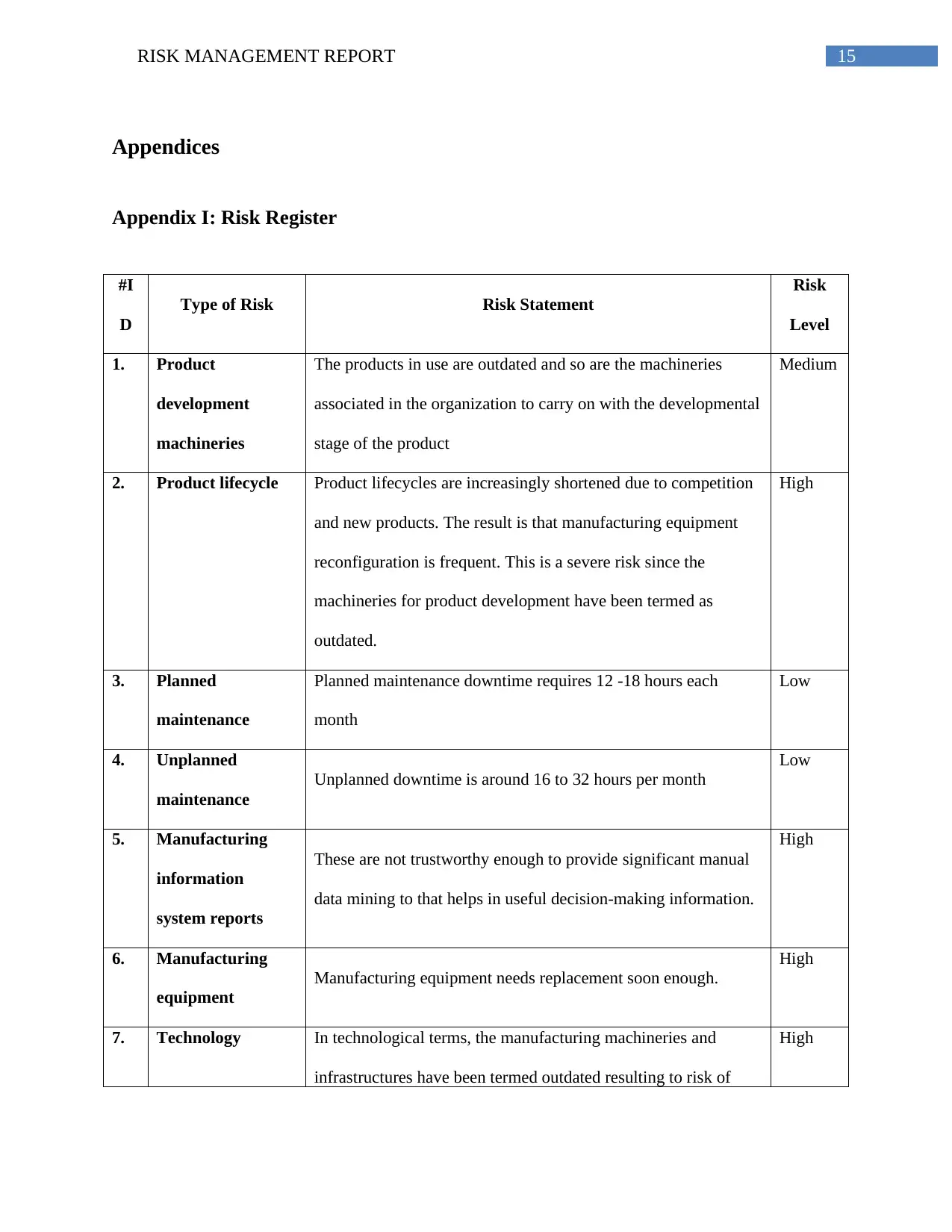
15RISK MANAGEMENT REPORT
Appendices
Appendix I: Risk Register
#I
D
Type of Risk Risk Statement
Risk
Level
1. Product
development
machineries
The products in use are outdated and so are the machineries
associated in the organization to carry on with the developmental
stage of the product
Medium
2. Product lifecycle Product lifecycles are increasingly shortened due to competition
and new products. The result is that manufacturing equipment
reconfiguration is frequent. This is a severe risk since the
machineries for product development have been termed as
outdated.
High
3. Planned
maintenance
Planned maintenance downtime requires 12 -18 hours each
month
Low
4. Unplanned
maintenance
Unplanned downtime is around 16 to 32 hours per month
Low
5. Manufacturing
information
system reports
These are not trustworthy enough to provide significant manual
data mining to that helps in useful decision-making information.
High
6. Manufacturing
equipment
Manufacturing equipment needs replacement soon enough.
High
7. Technology In technological terms, the manufacturing machineries and
infrastructures have been termed outdated resulting to risk of
High
Appendices
Appendix I: Risk Register
#I
D
Type of Risk Risk Statement
Risk
Level
1. Product
development
machineries
The products in use are outdated and so are the machineries
associated in the organization to carry on with the developmental
stage of the product
Medium
2. Product lifecycle Product lifecycles are increasingly shortened due to competition
and new products. The result is that manufacturing equipment
reconfiguration is frequent. This is a severe risk since the
machineries for product development have been termed as
outdated.
High
3. Planned
maintenance
Planned maintenance downtime requires 12 -18 hours each
month
Low
4. Unplanned
maintenance
Unplanned downtime is around 16 to 32 hours per month
Low
5. Manufacturing
information
system reports
These are not trustworthy enough to provide significant manual
data mining to that helps in useful decision-making information.
High
6. Manufacturing
equipment
Manufacturing equipment needs replacement soon enough.
High
7. Technology In technological terms, the manufacturing machineries and
infrastructures have been termed outdated resulting to risk of
High
Secure Best Marks with AI Grader
Need help grading? Try our AI Grader for instant feedback on your assignments.
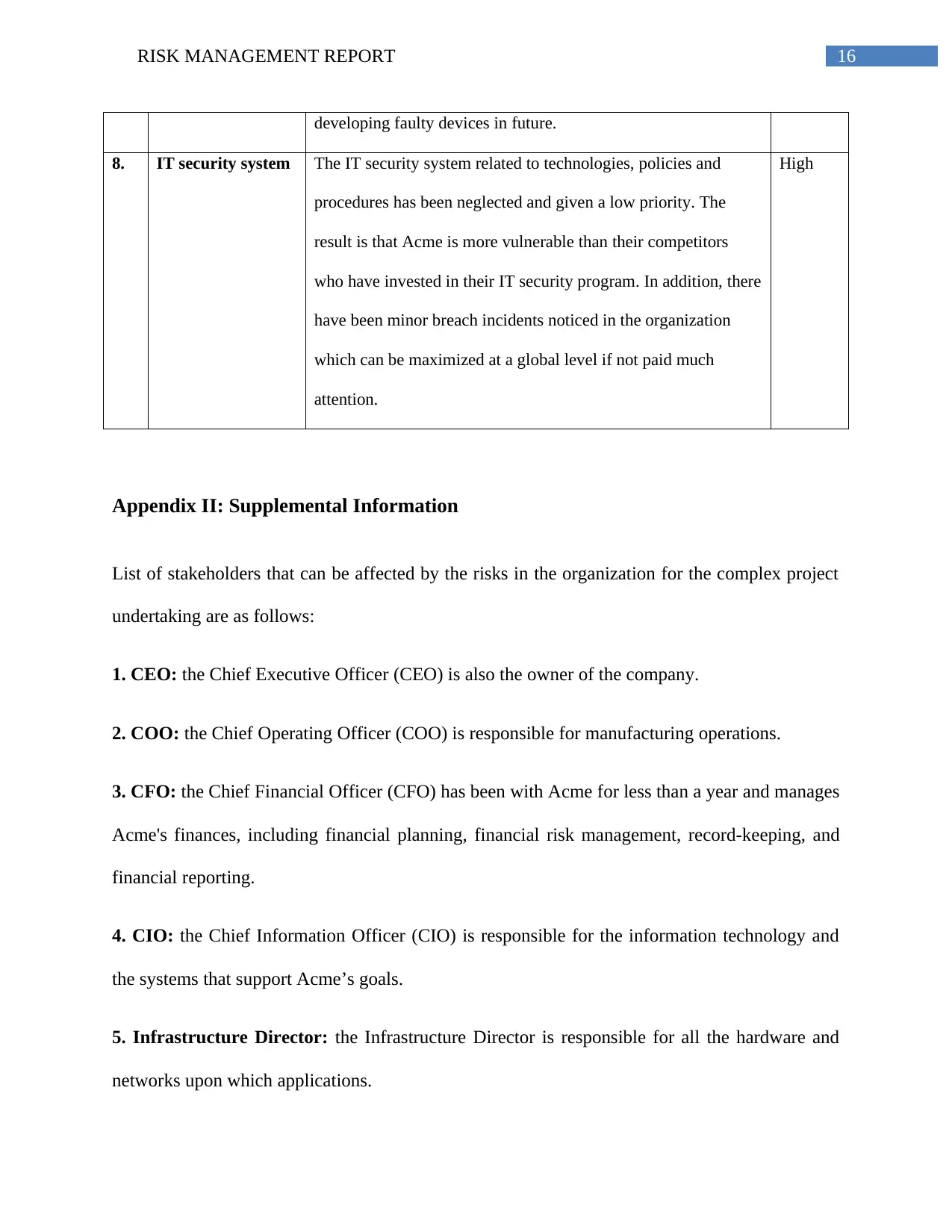
16RISK MANAGEMENT REPORT
developing faulty devices in future.
8. IT security system The IT security system related to technologies, policies and
procedures has been neglected and given a low priority. The
result is that Acme is more vulnerable than their competitors
who have invested in their IT security program. In addition, there
have been minor breach incidents noticed in the organization
which can be maximized at a global level if not paid much
attention.
High
Appendix II: Supplemental Information
List of stakeholders that can be affected by the risks in the organization for the complex project
undertaking are as follows:
1. CEO: the Chief Executive Officer (CEO) is also the owner of the company.
2. COO: the Chief Operating Officer (COO) is responsible for manufacturing operations.
3. CFO: the Chief Financial Officer (CFO) has been with Acme for less than a year and manages
Acme's finances, including financial planning, financial risk management, record-keeping, and
financial reporting.
4. CIO: the Chief Information Officer (CIO) is responsible for the information technology and
the systems that support Acme’s goals.
5. Infrastructure Director: the Infrastructure Director is responsible for all the hardware and
networks upon which applications.
developing faulty devices in future.
8. IT security system The IT security system related to technologies, policies and
procedures has been neglected and given a low priority. The
result is that Acme is more vulnerable than their competitors
who have invested in their IT security program. In addition, there
have been minor breach incidents noticed in the organization
which can be maximized at a global level if not paid much
attention.
High
Appendix II: Supplemental Information
List of stakeholders that can be affected by the risks in the organization for the complex project
undertaking are as follows:
1. CEO: the Chief Executive Officer (CEO) is also the owner of the company.
2. COO: the Chief Operating Officer (COO) is responsible for manufacturing operations.
3. CFO: the Chief Financial Officer (CFO) has been with Acme for less than a year and manages
Acme's finances, including financial planning, financial risk management, record-keeping, and
financial reporting.
4. CIO: the Chief Information Officer (CIO) is responsible for the information technology and
the systems that support Acme’s goals.
5. Infrastructure Director: the Infrastructure Director is responsible for all the hardware and
networks upon which applications.
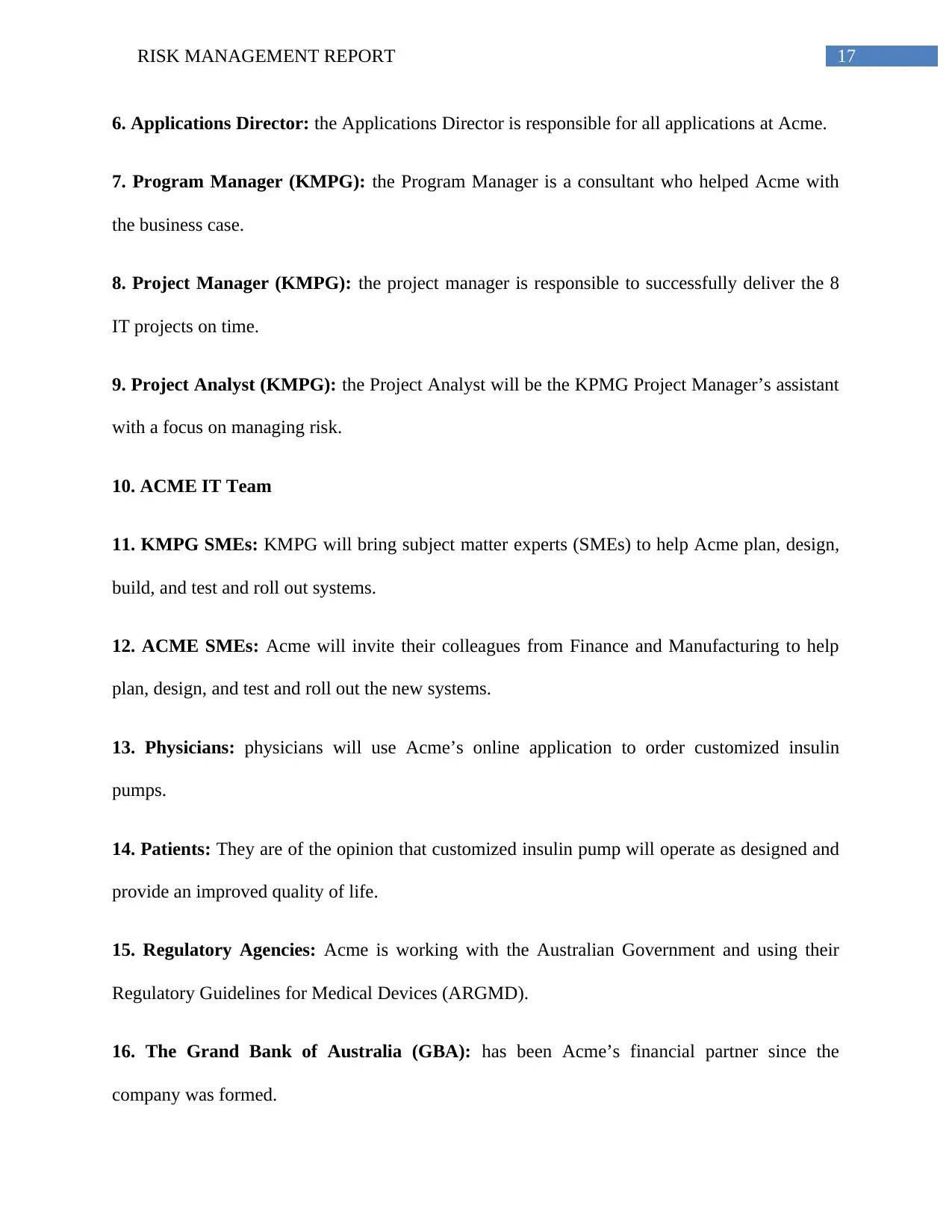
17RISK MANAGEMENT REPORT
6. Applications Director: the Applications Director is responsible for all applications at Acme.
7. Program Manager (KMPG): the Program Manager is a consultant who helped Acme with
the business case.
8. Project Manager (KMPG): the project manager is responsible to successfully deliver the 8
IT projects on time.
9. Project Analyst (KMPG): the Project Analyst will be the KPMG Project Manager’s assistant
with a focus on managing risk.
10. ACME IT Team
11. KMPG SMEs: KMPG will bring subject matter experts (SMEs) to help Acme plan, design,
build, and test and roll out systems.
12. ACME SMEs: Acme will invite their colleagues from Finance and Manufacturing to help
plan, design, and test and roll out the new systems.
13. Physicians: physicians will use Acme’s online application to order customized insulin
pumps.
14. Patients: They are of the opinion that customized insulin pump will operate as designed and
provide an improved quality of life.
15. Regulatory Agencies: Acme is working with the Australian Government and using their
Regulatory Guidelines for Medical Devices (ARGMD).
16. The Grand Bank of Australia (GBA): has been Acme’s financial partner since the
company was formed.
6. Applications Director: the Applications Director is responsible for all applications at Acme.
7. Program Manager (KMPG): the Program Manager is a consultant who helped Acme with
the business case.
8. Project Manager (KMPG): the project manager is responsible to successfully deliver the 8
IT projects on time.
9. Project Analyst (KMPG): the Project Analyst will be the KPMG Project Manager’s assistant
with a focus on managing risk.
10. ACME IT Team
11. KMPG SMEs: KMPG will bring subject matter experts (SMEs) to help Acme plan, design,
build, and test and roll out systems.
12. ACME SMEs: Acme will invite their colleagues from Finance and Manufacturing to help
plan, design, and test and roll out the new systems.
13. Physicians: physicians will use Acme’s online application to order customized insulin
pumps.
14. Patients: They are of the opinion that customized insulin pump will operate as designed and
provide an improved quality of life.
15. Regulatory Agencies: Acme is working with the Australian Government and using their
Regulatory Guidelines for Medical Devices (ARGMD).
16. The Grand Bank of Australia (GBA): has been Acme’s financial partner since the
company was formed.
1 out of 18
Related Documents
Your All-in-One AI-Powered Toolkit for Academic Success.
+13062052269
info@desklib.com
Available 24*7 on WhatsApp / Email
![[object Object]](/_next/static/media/star-bottom.7253800d.svg)
Unlock your academic potential
© 2024 | Zucol Services PVT LTD | All rights reserved.



